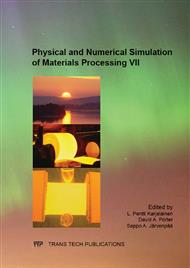p.411
p.418
p.424
p.431
p.437
p.445
p.451
p.457
p.465
The Effect of Bonding Flaws on the Splitting Process in the Smart-Cut Technology
Abstract:
Smart-Cut® is an innovative and highly efficient technology to fabricate high quality Silicon-on-Insulator (SOI) wafers, especially when the top film of SOI wafers is very thin. In the present paper, a fracture mechanics model is established to examine the effect of bonding flaws on defect growth in the Smart-Cut process. It is found that although defect growth can occur in a practical Smart-Cut process, large bonding flaws are inclined resulting in severe deviation of the direction of defect propagation, leading to a non-transferred area of thin film when splitting. Moreover, at the expense of low defect growth, increasing the internal pressure of bonding flaws decreases the defect growth deviation and thus benefits to improve the quality of final SOI wafer. The mechanism of relaxation of stiffener constraint is proposed to clarify the effect of bonding flaws. Finally, progress of the splitting process is analyzed when bonding flaws are present.
Info:
Periodical:
Pages:
437-444
Citation:
Online since:
July 2013
Authors:
Keywords:
Price:
Сopyright:
© 2013 Trans Tech Publications Ltd. All Rights Reserved
Share:
Citation:


